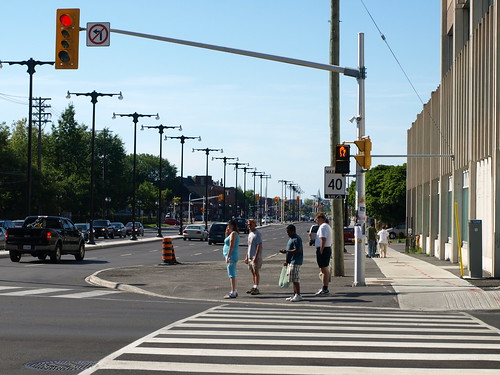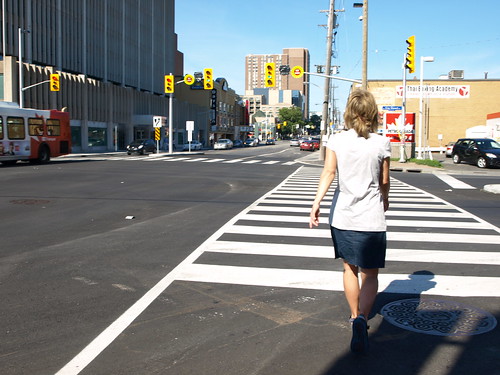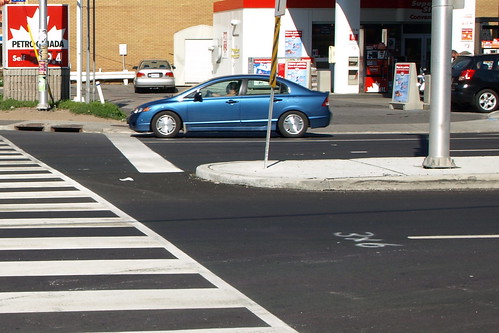
That’s how Geography professor Barry Wellar terms the corner of King Edward and Rideau, and when it comes to the pedestrian experience of Ottawa intersections, he should know. He is the researcher behind the Ottawa Carleton Walking Security Index, which, though it has been largely ignored by Ottawa road planners since its publication nearly 10 years ago, has helped to establish the U of O prof as one of North America’s foremost experts on pedestrian safety.
Of course, it won’t be news to anyone who has ever spent time walking in Lowertown that King Edward is a disaster for those on foot. In fact, the thoroughfare is considered so threatening to the nearby urban environment that it has led to the creation of a neighbourhood action group solely dedicated to bringing about a safer and more pedestrian-friendly road. With thousands of trucks rumbling down the avenue at speed every day it’s hard to believe it was once an intimate and leafy European-style “true” boulevard, as in photos like this.
With Becky Rynor’s recent article about Wellar in the Citizen fresh in my mind, on a recent Saturday I visited the notorious corner. I had heard that some changes had been made to the intersection, and I wanted to see for myself if they made a difference to that intangible yet all-important metric for pedestrian comfort – the way someone on foot “feels” when they are in negotiating a busy crossing.
One aspect that jumps out are the freshly-painted crosswalks:

These are relatively wide (for Ottawa) and clearly marked, serving as a visual reminder to motorists that yes, pedestrians exist and can be expected to use the intersection as a place of crossing — so slow down.
Next up we noticed the median islands. These should act as “refuge” zones in a multi-lane arterial; slower walkers need to be assured that if they fail to cross the entire width of the street in a given light cycle, they can take up a waiting position halfway, and watch safely for the next light in their favour. Unfortunately the newly-poured medians are narrow, set well back of the actual crosswalk, and cluttered with signage for motorists, sending a strong signal to pedestrians that despite their sidewalk-like surface, the islands are really not for them.

In the photo above we can also note a further change; boldly painted “stop lines” keeping cars away from the crosswalk area. Wellar advises that such stop lines should be set back one full car length behind the intersection, as slippy winter conditions can make coming to a full stop more difficult. This stop line is clearly not set back that far. With the speed of traffic coming downhill to the intersection from Laurier, it should be at least one car length, and perhaps more.
But the biggest change has been in the way the north side of the intersection has seen the construction of a large “bulb out” to block off the easternmost lane of King Edward. This bulb-out can be seen in the photo at the top of this story, and there is no question that it is easier for pedestrians to negotiate the crossing of a two-lane northbound stream than the old three-lane version.
So with that substantial barrier it should feel significantly more comfortable for walking traffic along the north side of Rideau, but the construction of the bulb-out also included a shaved turning radius ( see photo below) that means that drivers turning off Rideau to go north on King Edward are given tacit permission to roll around the corner at a speed dangerous to pedestrians caught out by a light change. Even walkers scrupulously following the signals will be looking over their left shoulder to make sure the car-friendly turning angle hasn’t inspired impatient drivers to nose through the crosswalk as they do at most other intersections in the city.

So overall, I give the changes mixed marks. Some changes do make for a safer feel to the intersection, but more could easily have been done. Significant changes to overly-car-friendly turning radii seem to be something that Ottawa road engineers will go to their graves fighting and gnashing their teeth over; shaved corners are problem all over the city. But usable medians and properly set-back stop lines are a matter of more cement in the mixer and some fresh paint; there is still time for the City to get it right.

7 comments
The worst are those right-turning STO buses on the NW corner. They don’t stop for anything.
Whether you agree with it or not, the City’s policy is to not implement pedestrian refuges at medians. Rather, they set the signals so that there should be enough time to get across during the flashing hand signal. (If you enter the crosswalk during the flashing hand–which is illegal–you’re on your own).
I think the City and province need to do a lot more enforcement and public education to reinforce the fact that when any part of your vehicle crosses the stop line, you are in the intersection. If the light is red, you have illegally entered that intersection. If you don’t stop until after you’ve crossed that line, you have failed to make a legal stop at the intersection.
On a more positive note, this is the first I’ve seen of the redeveloped KEA, and the new median light standards look nice.
It’s definitely an improvement and I’m grateful for it. In any event, I tend to avoid the issue by crossing at Besserer rather than Rideau. This, of course, is only because it’s more convenient for me.
I have mixed feelings about King Eddy and esp. this intersection. It still seems too wide, too hostile to pedestrians. The huge turning radius on the NE side is awful. And the islands stop short of the crosswalks [the result of a judge determining that islands are unfriendly to the handicapped or some such thing] whereas the correct solution would have been to cut the island 90 degrees at the crosswalk and build another segment of it beyond the crosswalk, forcing cars to make sharper turns at lower speeds while giving peds a real refuge in the middle.This may also have moved the crosswalk a meter or so further from the intersection so as to cut the median in a useful way.
This bit about there being enough time to cross is a laugh … roads are designed for how people drive, not how they should drive, so why do we expect perfection from peds? If people are regularly caught out, fix the infrastructure, don’t tich tich the people who are tired of being treated like second class or worse.
Finally, eliminate the right turns on reds everywhere in the city, or inside the areas built up pre 1950, where there are peds.
– Eric Darwin
http://www.WestSideAction.blogspot.com.
I just watch this interesting footage at Monocle about urban planning. Kind of the opposite of what they have done with King Edward….
http://www.monocle.com/sections/design/Web-Articles/Master-Planner-Jan-Gehl/
I doubt this is the worst intersection in Ottawa…has anyone ever crossed at Carling and Holland?
any intersection which acts as the dumping point for a 6 lane expressway (A-5) will have pedestrian difficulties. the entire neighbourhood needs a rethinking of 1-way streets to move cars comfortably from nicholas st. to the macdonald bridge.
“Wellar advises that such stop lines should be set back one full car length behind the intersection, as slippy winter conditions can make coming to a full stop more difficult.”
That just encourages right-turners to creep ahead past the stop line to check for cross traffic, which leads to them just not stopping until they’re at the edge of the travelled portion of the road anyway. “Slippy winter conditions” conceal the stop line, and even if it’s visible, a driver who doesn’t drive according to conditions is going to go slithering into an intersection sooner or later (I’ve seen it happen with northbound traffic coming down the hill at that particular location).
So, I’m not sure that putting the stop lines a mile back from the edge of the road is really useful, and it probably encourages people to ignore them.